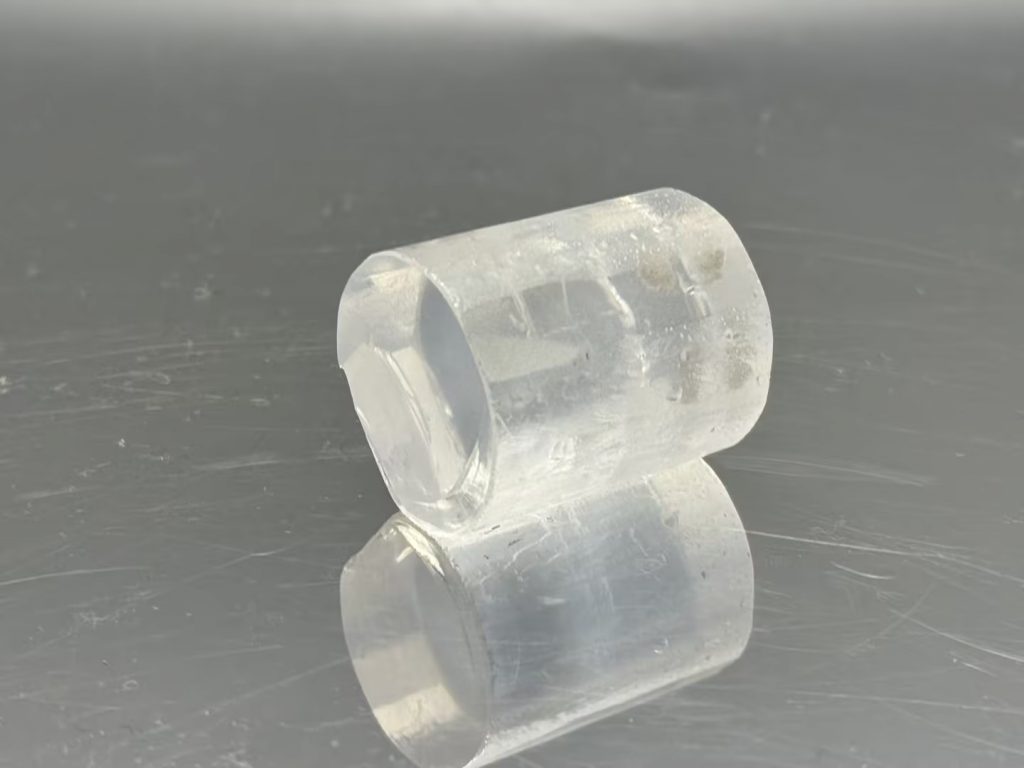1.Introduction
Yb:CALGO crystals are ideal gain media for high-power, ultrafast laser systems due to their excellent thermal and spectral properties. Their broadband emission properties enable them to support the generation of ultrashort pulses, while the high thermal conductivity helps to maintain a stable laser output at high power pumping.
The doping concentration of Yb:CALGO crystals is limited by the difference in concentration between the raw material ratio and the final product, resulting in the limitations of traditional methods of evaluating the concentration of the crystals to accurately reflect the performance of the crystals in real-world applications.
With years of research on Yb:CALGO crystals, Crylink believes that the absorption coefficient at 980 nm should be used to evaluate the performance and actual doping concentration of Yb:CALGO crystals, which can more directly reflect the absorption efficiency and laser performance of the crystals under the action of pump light.
2.Yb:CALGO Crystal Properties
2.1 Structure and composition
Yb:CALGO crystals belong to the tetragonal crystal system, in which Ca²⁺ and Gd³⁺ ions share the same lattice site in the structure, and Yb³⁺ ions can replace these two ions. This structure leads to the disordered nature of the crystals, which produces wide absorption and emission bands that are favorable for ultrafast lasers.
2.2 Spectral Properties
The Yb:CALGO crystals have broad absorption and emission bands in the 1 μm band, with a significant absorption peak near 980 nm. The position of this absorption peak matches the emission wavelength of the commonly used high-power InGaAs diode pump source, enabling the Yb:CALGO crystal to absorb the pump light efficiently, thus realizing high-power laser output.
3.Absorption Coefficient and Doping Concentration of Yb:CALGO
3.1 Limitations of conventional doping concentration
The conventional doping concentration of Yb:CALGO is calculated as the molar fraction of Yb³⁺ ions added during crystal growth. However, the Yb³⁺ ion concentration in actual crystals may differ from the theoretical doping concentration due to factors such as the partition coefficient and growth conditions. For example, in the article “Research progress of Yb:CaGdAlO4 crystal and its ultrafast laser technology” by X. H. Liu, it is mentioned that the partition coefficient of Yb is about 0.6, and the Yb³⁺ ion doping concentration of the actual grown crystal may be lower than that of the dosed crystal. The actual Yb doping concentration in the grown crystal may be lower than the dosage doping concentration.
In addition, defects, impurities, and inhomogeneities in the crystal growth process may also affect the doping concentration distribution, resulting in inaccurate performance evaluation based on doping concentration of Yb:CALGO.
3.2 Advantage of absorption coefficient at 980 nm
980 nm serves as the peak value of the absorption peak of Yb:CALGO crystals, so the absorption coefficient at 980 nm directly reflects the absorption efficiency of Yb:CALGO under the action of pump light. A higher absorption coefficient means that the crystal is able to absorb the pump light more efficiently, and accordingly the laser output power and efficiency will be higher.
By measuring the absorption coefficient at 980 nm, Crylink can more accurately evaluate the actual performance of the crystal, including gain factor, laser threshold, and output power. In addition, the absorption coefficient is relatively simple to measure and can be measured directly by a spectrum analyzer with high repeatability and reliability.
4. Experiments and Results
4.1 Experimental method
In order to verify the validity of the absorption coefficient at 980 nm in evaluating the properties of Yb:CALGO crystals, we refer to J. Boudeile’s “Continuous-wave and femtosecond laser operation of Yb:CaGdAlO4 under high-power diode pumping,” Opt. Lett. 32(14), 1962–1964 (2007). and A. Jaffrès, “Yb:CALGO as material for high power ultrafast laser and focus on thermal conductivity variation,” Proc. SPIE 8621, 86211S (2013), etc.
The experimental methods in the references are as follows: 1. Yb:CALGO crystals with different doping concentrations of 2%, 5%, and 10% were grown by the Czochralski method, and the absorption coefficients at 980 nm were measured with a spectral analyzer. 3. Under the same pumping conditions, the laser output power, pulse width and beam quality of different crystals were tested.
4.2 Analysis of results
The experimental results in the references show that the absorption coefficient at 980 nm is closely related to the laser performance. The specific results are as follows:
1. Absorption coefficient and output power: Crystals with higher absorption coefficients at 980 nm exhibit higher output power under the same pumping conditions. For example, the absorption coefficient at 980 nm for a crystal with 2% doping concentration is 0.7 cm-1 and the output power is 11.1 W, while that for a crystal with 5% doping concentration is 1.2 cm-1 and the output power is 16.5 W. The results are as follows: 1. Absorption coefficient versus pulse width: The higher absorption coefficient at 980 nm shows higher output power under the same pumping conditions.
2. Absorption coefficient and pulse width: Crystals with higher absorption coefficients can support shorter pulse widths. For example, the absorption coefficient at 980 nm for a 2% dopant concentration crystal is 0.7 cm-1 and the pulse width is 47 fs, while the absorption coefficient at 980 nm for a 5% dopant concentration crystal is 1.2 cm-1 and the pulse width is 32 fs, as shown in [2].
3. Absorption coefficient and beam quality: Crystals with higher absorption coefficients also show better performance in terms of beam quality. For example, the absorption coefficient at 980 nm for a 2% doping concentration crystal in literature [3] is 0.7 cm-1 with a beam quality factor M² of 1.2, while the absorption coefficient at 980 nm for a 5% doping concentration crystal is 1.2 cm-1 with a beam quality factor M² of 1.1.

Fig.1 2%Yb at Doping Concentration of Yb:CALGO Raw Crystal
5. Conclusion
Through comparative analysis, this paper demonstrates the advantage of the absorption coefficient at 980 nm in evaluating the performance of Yb:CALGO crystals. Compared with the traditional doping concentration of Yb:CALGO, the absorption coefficient can more directly and accurately reflect the performance of the crystal in practical applications. Crystals with high absorption coefficients show excellent performance in terms of output power, pulse width and beam quality.
Therefore, it is suggested that the absorption coefficient at 980 nm is preferred to evaluate the performance and actual concentration of the crystals in the research and application of Yb:CALGO crystals in order to improve the accuracy and reliability of the evaluation.
Reference
1.J. Boudeile, F. Druon, M. Hanna, et al., “Continuous-wave and femtosecond laser operation of Yb:CaGdAlO4 under high-power diode pumping,” Opt. Lett. 32(14), 1962–1964 (2007).
2.A. Jaffrès, S. Ricaud, A. Suganuma, B. Viana, P. Loiseau, P. Georges, and F. Druon, “Yb:CALGO as material for high power ultrafast laser and focus on thermal conductivity variation,” Proc. SPIE 8621, 86211S (2013).
3. X. H. Liu, J. F. Li, Z. J. Zhu, C. Y. Tu, G. Y. Wang, J. F. Yang, J. F. Zhu, and Y. Wang, “Research progress of Yb:CaGdAlO4 crystal and its ultrafast laser technology,” Journal of Synthetic Crystals, vol. 52, no. 7, pp. 1195-1207(2023).
4.F. Trawi, J. Drs, M. Müller, M. Hamrouni, V. J. Wittwer, and T. Südmeyer, “Sub-30-fs Yb:CALGO laser oscillator based on cross-polarized multi-mode diode pumping,” Opt. Express 32(21), 37897–37904 (2024).
5. A. Agnesi, A. Greborio, F. Pirzio, G. Reali, J. Aus der Au, and A. Guandalini, “40-fs Yb3+:CaGdAlO4 laser pumped by a single-mode 350-mW laser diode,” Opt. Express 20(9), 10077–10082 (2012)

Frank
Frank graduated from the University of Shanghai for Science and Technology, majoring in optics. As a technical engineer at Crylink Company, he deeply understands crystal materials and laser components.
Related Video(s) with this Article
Related Product(s) with this Article
Related Application(s) with this Article
